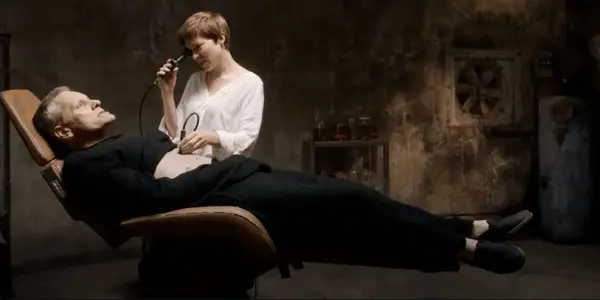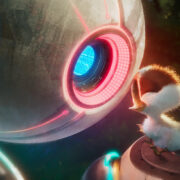CRIMES OF THE FUTURE: The Beautiful & Revolting Human Form

Soham Gadre is a writer/filmmaker in the Washington D.C. area.…
David Cronenberg’s output before the turn of the 21st century was vastly different than what came before it. Crimes of the Future returns to the 20th century Cronenberg with an equal parts sultry and revolting look at the ways the human body can annihilate and exhilarate itself. One of the most unique visionary artists of his era, Cronenberg considers sex, flesh, organs, and blood as deeply personal, sensual but also astoundingly weird acts of biology. There is a thin line between us and the aliens and bugs we invent for movies and Cronenberg are here to merge them together. In Crimes of the Future, the horrors and beauty of the human anatomy, both inside and out, are a work of grotesque art and performance. We look at our own bodies with fascination and revulsion – we are both sexually attracted to and disgustingly ashamed of our flesh.
New Sex, New Body, Same Cronenberg
What thin strands of a plot that exist in this film go something like this: A young boy who is able to digest plastic is killed by his own mother, who refers to him as a “creature”. Elsewhere two performance partners, Caprice (Lea Seydoux) and Saul Tenser (Viggo Mortensen), live together in a strange castle-like house. Saul suffers from constant pain throughout his body and sleeps in a bed shaped like an upside-down bed bug that moves with his body trying to soothe it while he sleeps. He also has trouble eating and swallowing and sits in a chair made of weird moving bones that also are constantly moving him around trying to ease his pain as much as possible. Caprice is an artist and her art is basically cutting Saul open in front of a crowd and performing tattoo surgery on his organs, many of which are new growing organs that the human species has never developed before until him.

Surgery is the new sex is a phrase that has become instantly popular in the film, not unlike “welcome the new flesh” from Cronenberg’s Videodrome. These considerations of the new and evolving understanding of the human body reveal strange and fascinating pleasures for characters in Cronenberg‘s films. Timlin (Kristen Stewart) is a research assistant who develops a sexual attraction to Saul and wants to see him cut open. Sexual pleasure is derived in the film as intimate contact with the internals of the human body, not necessarily in or near the genitalia anymore. Pleasure is everywhere – every wound, every gaping bleeding slit is a place where the human form can attain arousal with itself.
Kristen Stewart Stands Out
Seydoux and Viggo Mortensen play off each other well, eliciting a strangely distant and longing form of sexual tension that plays in contrast with Timlin’s carnal attraction for him. Kristen Stewart is really the standout here. Her stuttering and sheepishness are usually utilized for dour and aggrieved roles but they have turned around here for a very strangely potent sexual desire that really sells the idea of a “new sex”.

In this future world – we don’t know how far into the future exactly we are – behaviors and obsessions are found in things slightly removed from a current reality but tied intrinsically to the innate nature of mankind. Our obsession with our own and each other’s bodies, manifest in a constant state of adaptation or improvement or reclamation of a state that is long gone, is what drives sexuality in Crimes of the Future. That doesn’t sound so crazy.
Conclusion
The boy from the beginning of the movie turns out to have a condition that is a byproduct of human evolution. New organs, a new digestive system. Certain people have already grown these and eat plastic candy bars that look purplish in color. The boy’s father, says this stage of human evolution is necessary for the world’s survival. Humans have grown to be able to consume the waste that they have killed the Earth with. Saul Tenser seems to be similar to them, but he resists and he has his new organs removed periodically to keep himself in his original human form. Surgery, art, sex, and evolution are four nodes of an intricate web of our near future. Like Tenser in the last shot of the film, it will take us time to but we will inevitably succumb to it.
Have you seen Crimes of the Future? What did you think? Let us know in the comments below!
Crimes of the Future was released in U.S. theaters on June 2, 2022!
Watch Crimes of the Future
Does content like this matter to you?
Become a Member and support film journalism. Unlock access to all of Film Inquiry`s great articles. Join a community of like-minded readers who are passionate about cinema - get access to our private members Network, give back to independent filmmakers, and more.
Soham Gadre is a writer/filmmaker in the Washington D.C. area. He has written for Hyperallergic, MUBI Notebook, Popula, Vague Visages, and Bustle among others. He also works full-time for an environmental non-profit and is a screener for the Environmental Film Festival. Outside of film, he is a Chicago Bulls fan and frequenter of gastropubs.










